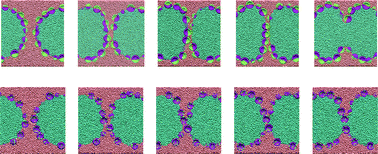Mechanistic study of droplets coalescence in Pickering emulsions
Abstract
Dissipative particle dynamics (DPD) simulations were performed to study the stability of Pickering emulsions. Two droplets covered by

* Corresponding authors
a
The University of Oklahoma, School of Chemical, Biological, and Materials Engineering, Norman, Oklahoma 73019, USA
E-mail:
astriolo@ou.edu
Dissipative particle dynamics (DPD) simulations were performed to study the stability of Pickering emulsions. Two droplets covered by

 Please wait while we load your content...
Something went wrong. Try again?
Please wait while we load your content...
Something went wrong. Try again?
H. Fan and A. Striolo, Soft Matter, 2012, 8, 9533 DOI: 10.1039/C2SM26416A
To request permission to reproduce material from this article, please go to the Copyright Clearance Center request page.
If you are an author contributing to an RSC publication, you do not need to request permission provided correct acknowledgement is given.
If you are the author of this article, you do not need to request permission to reproduce figures and diagrams provided correct acknowledgement is given. If you want to reproduce the whole article in a third-party publication (excluding your thesis/dissertation for which permission is not required) please go to the Copyright Clearance Center request page.
Read more about how to correctly acknowledge RSC content.
 Fetching data from CrossRef.
Fetching data from CrossRef.
This may take some time to load.
Loading related content
